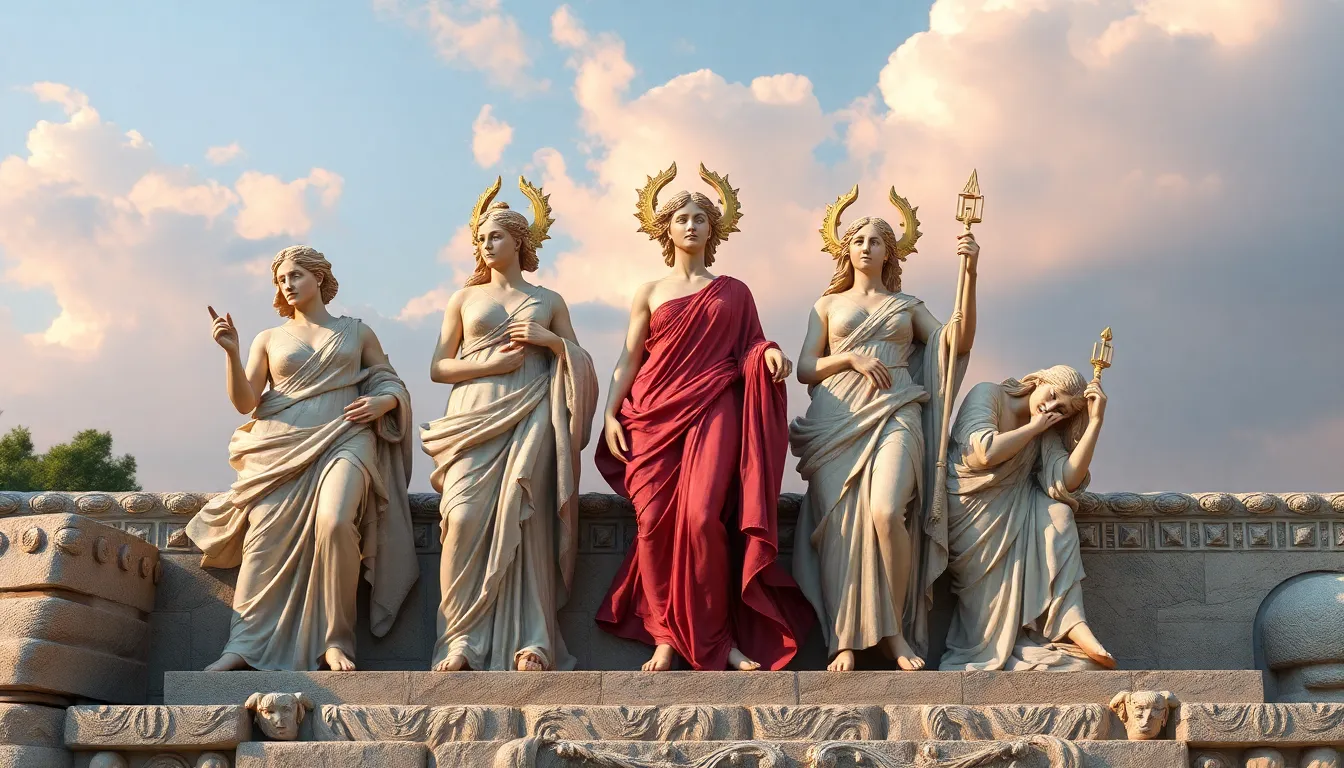The Muses and Their Influence on the Arts in Ancient Rome
I. Introduction
The Muses, in Greek mythology, are the nine goddesses of the arts and sciences, each representing a specific domain of creativity and knowledge. They are often invoked by poets and artists as sources of inspiration. The significance of the Muses transcended into Roman culture, where they were embraced and adapted, becoming pivotal figures in the artistic landscape of ancient Rome.
This article explores the origins and transformations of the Muses, their influence on the arts in ancient Rome, and their enduring legacy. We will delve into their individual attributes, their depictions in literature and visual arts, and their role in music and performance.
II. The Origins of the Muses
The Muses originated in Greek mythology, believed to be the daughters of Zeus and Mnemosyne, the goddess of memory. Each Muse represents a different aspect of the arts, including epic poetry, history, lyric poetry, tragedy, comedy, music, astronomy, and dance. Their presence was essential to the cultural fabric of ancient Greece.
When the Romans adopted Greek mythology, they integrated the Muses into their own culture, preserving their identities while also transforming their roles. In Roman society, the Muses were often seen as embodiments of inspiration for various forms of artistic expression, and they were celebrated in literature, sculpture, and performance.
III. The Nine Muses and Their Domains
The nine Muses and their respective domains are as follows:
- Calliope – Muse of epic poetry
- Clio – Muse of history
- Erato – Muse of lyric poetry
- Euterpe – Muse of music
- Melpomene – Muse of tragedy
- Polyhymnia – Muse of sacred poetry
- Terpsichore – Muse of dance
- Thalia – Muse of comedy
- Urania – Muse of astronomy
Each Muse influenced specific art forms, inspiring artists and scholars to create notable works. For example, Calliope inspired epic poets like Homer, while Euterpe influenced musicians and composers to create timeless melodies. The Muses were often invoked at the beginning of artistic works, signifying their importance in the creative process.
IV. The Muses in Roman Literature
The Muses were prominently featured in Roman literature, serving as symbols of inspiration for poets and writers. Roman authors such as Virgil, Ovid, and Horace often cited the Muses in their works, reflecting their role in the creative process.
For instance, Virgil invoked the Muses in his epic poem “The Aeneid,” seeking divine inspiration to tell the story of Aeneas. Similarly, Ovid referred to the Muses in “Metamorphoses,” aligning his poetic transformations with the divine creativity of the goddesses.
The Muses not only inspired individual works but also shaped literary themes and narratives. They represented the connection between the divine and human creativity, highlighting the importance of inspiration in the arts.
V. The Muses in Visual Arts
In Roman sculpture and painting, the Muses were frequently depicted, often personified in artistic works. Artists portrayed them in various forms, capturing their unique attributes and associations with different art forms.
For example, marble sculptures of the Muses adorned public spaces, while frescoes in Roman villas illustrated their influence on the arts. The Muses were often depicted in a harmonious arrangement, symbolizing the interconnectedness of different artistic disciplines.
Notable artworks connected to the Muses include:
- The Muses of the Villa Medici, a famous fresco by the artist Raphael.
- The “Muses of the Montemartini,” ancient sculptures showcasing each Muse’s distinct characteristics.
These artistic representations not only celebrated the Muses but also influenced artistic techniques and styles, contributing to the evolution of Roman visual arts.
VI. The Muses and Music in Ancient Rome
The Muses held a significant influence on Roman music and performance arts. Euterpe, the Muse of music, inspired composers and musicians to create elaborate symphonies and songs that resonated with the public.
Music played a vital role in Roman festivities and rituals, often accompanied by performances that celebrated the gods and the arts. The connection between the Muses and music was evident in the way musicians invoked Euterpe for inspiration during public performances and private gatherings.
Furthermore, the Muses were instrumental in the development of Roman theatre, where dramatic performances would often pay homage to the goddesses. Theatrical works showcased the talents of actors and musicians, merging various art forms into a cohesive experience.
VII. The Legacy of the Muses in Roman Culture
The Muses have left an indelible mark on Roman culture, symbolizing inspiration and creativity across various art forms. Their influence can be seen not only in ancient Roman art and literature but also in later movements, including the Renaissance.
During the Renaissance, artists and scholars revived interest in classical themes, leading to a resurgence of the Muses in artistic expression. They became symbols of enlightenment and the pursuit of knowledge, inspiring countless works across different media.
Today, the Muses continue to inspire artists, writers, and creators, serving as a reminder of the power of creativity and the enduring quest for inspiration.
VIII. Conclusion
In summary, the Muses played a crucial role in shaping the arts in ancient Rome, influencing literature, visual arts, and music. Their presence not only inspired individual works but also fostered a cultural environment rich in creativity and expression.
Preserving the legacy of the Muses is essential, as they symbolize the timeless power of inspiration in the arts. Their influence reminds us of the importance of creativity in human experience and the ongoing quest for artistic expression.
Ultimately, the Muses continue to resonate within the hearts and minds of artists and creators, embodying the spirit of inspiration that drives the arts forward.




